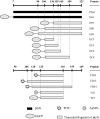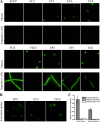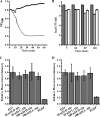Existence of separate domains in lysin PlyG for recognizing Bacillus anthracis spores and vegetative cells
- PMID: 22802245
- PMCID: PMC3457386
- DOI: 10.1128/AAC.00891-12
Existence of separate domains in lysin PlyG for recognizing Bacillus anthracis spores and vegetative cells
Abstract
As a potential antimicrobial, the bacteriophage lysin PlyG has been reported to specifically recognize Bacillus anthracis vegetative cells only and to kill B. anthracis vegetative cells and its germinating spores. However, how PlyG interacts with B. anthracis spores remains unclear. Herein, a 60-amino-acid domain in PlyG (residues 106 to 165), located mainly in the previously identified catalytic domain, was found able to specifically recognize B. anthracis spores but not vegetative cells. The exosporium of the spores was found to be the most probable binding target of this domain. This is the first time that a lysin for spore-forming bacteria has been found to have separate domains to recognize spores and vegetative cells, which might help in understanding the coevolution of phages with spore-forming bacteria. Besides providing new biomarkers for developing better assays for identifying B. anthracis spores, the newly found domain may be helpful in developing PlyG as a preventive antibiotic to reduce the threat of anthrax in suspected exposures to B. anthracis spores.
Figures







Similar articles
-
Characterization of the catalytic activity of the gamma-phage lysin, PlyG, specific for Bacillus anthracis.FEMS Microbiol Lett. 2008 Sep;286(2):236-40. doi: 10.1111/j.1574-6968.2008.01280.x. Epub 2008 Jul 25. FEMS Microbiol Lett. 2008. PMID: 18662316
-
Gamma-phage lysin PlyG sequence-based synthetic peptides coupled with Qdot-nanocrystals are useful for developing detection methods for Bacillus anthracis by using its surrogates, B. anthracis-Sterne and B. cereus-4342.BMC Biotechnol. 2009 Jul 22;9:67. doi: 10.1186/1472-6750-9-67. BMC Biotechnol. 2009. PMID: 19624851 Free PMC article.
-
The secondary cell wall polysaccharide of Bacillus anthracis provides the specific binding ligand for the C-terminal cell wall-binding domain of two phage endolysins, PlyL and PlyG.Glycobiology. 2013 Jul;23(7):820-32. doi: 10.1093/glycob/cwt019. Epub 2013 Mar 14. Glycobiology. 2013. PMID: 23493680 Free PMC article.
-
The Bacillus anthracis Exosporium: What's the Big "Hairy" Deal?Microbiol Spectr. 2015 Oct;3(5). doi: 10.1128/microbiolspec.TBS-0021-2015. Microbiol Spectr. 2015. PMID: 26542035 Review.
-
Proteomic studies of Bacillus anthracis.Future Microbiol. 2009 Oct;4(8):983-98. doi: 10.2217/fmb.09.73. Future Microbiol. 2009. PMID: 19824790 Review.
Cited by
-
Antibacterial Activity of a Novel Peptide-Modified Lysin Against Acinetobacter baumannii and Pseudomonas aeruginosa.Front Microbiol. 2015 Dec 22;6:1471. doi: 10.3389/fmicb.2015.01471. eCollection 2015. Front Microbiol. 2015. PMID: 26733995 Free PMC article.
-
Pulling the Brakes on Fast and Furious Multiple Drug-Resistant (MDR) Bacteria.Int J Mol Sci. 2021 Jan 16;22(2):859. doi: 10.3390/ijms22020859. Int J Mol Sci. 2021. PMID: 33467089 Free PMC article. Review.
-
Bacillus-infecting bacteriophage Izhevsk harbors thermostable endolysin with broad range specificity.PLoS One. 2020 Nov 24;15(11):e0242657. doi: 10.1371/journal.pone.0242657. eCollection 2020. PLoS One. 2020. PMID: 33232350 Free PMC article.
-
Monomodular Pseudomonas aeruginosa phage JG004 lysozyme (Pae87) contains a bacterial surface-active antimicrobial peptide-like region and a possible substrate-binding subdomain.Acta Crystallogr D Struct Biol. 2022 Apr 1;78(Pt 4):435-454. doi: 10.1107/S2059798322000936. Epub 2022 Mar 4. Acta Crystallogr D Struct Biol. 2022. PMID: 35362467 Free PMC article.
-
Phage therapy: An alternative to antibiotics in the age of multi-drug resistance.World J Gastrointest Pharmacol Ther. 2017 Aug 6;8(3):162-173. doi: 10.4292/wjgpt.v8.i3.162. World J Gastrointest Pharmacol Ther. 2017. PMID: 28828194 Free PMC article. Review.
References
Publication types
MeSH terms
Substances
LinkOut - more resources
Full Text Sources
Other Literature Sources
Research Materials

